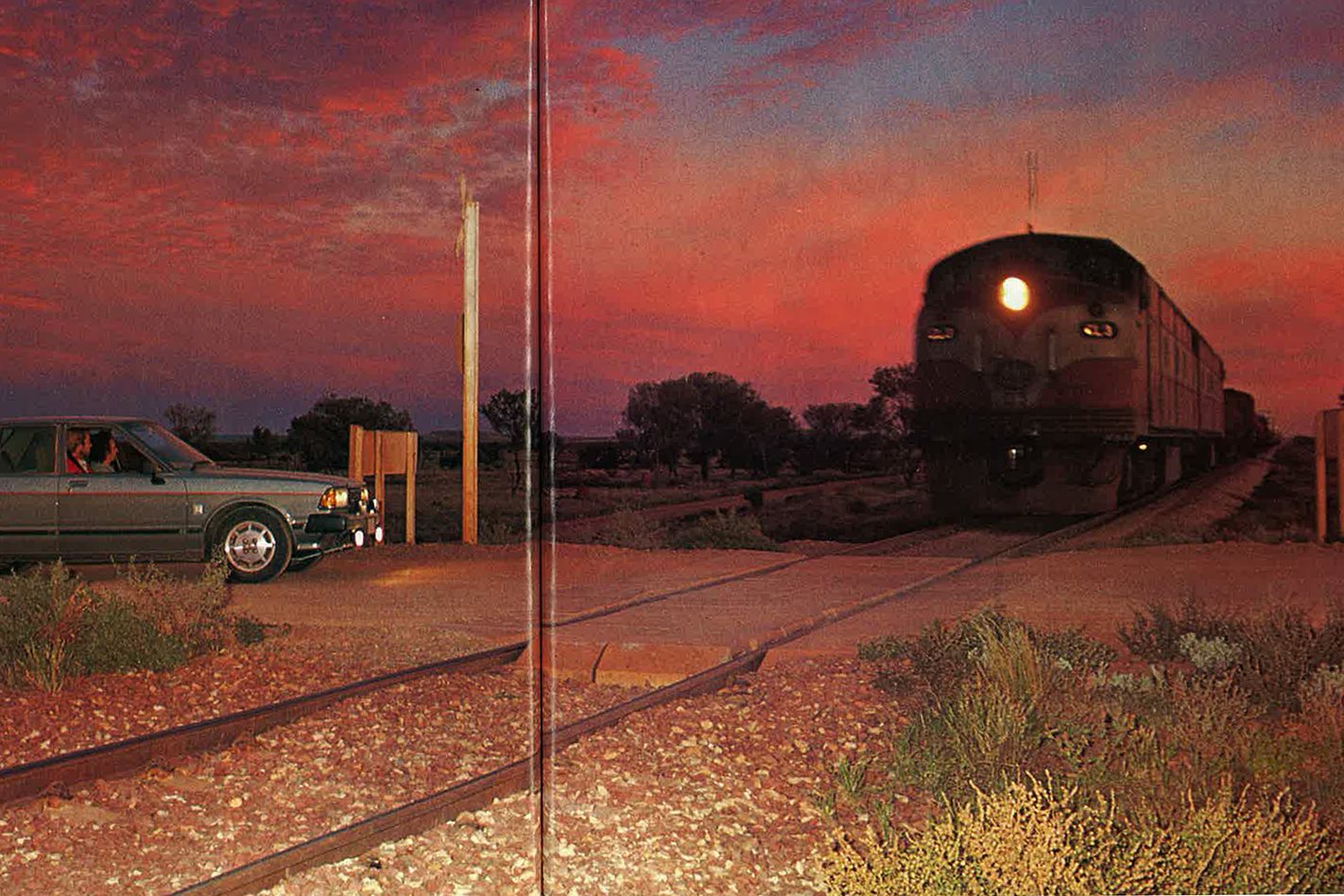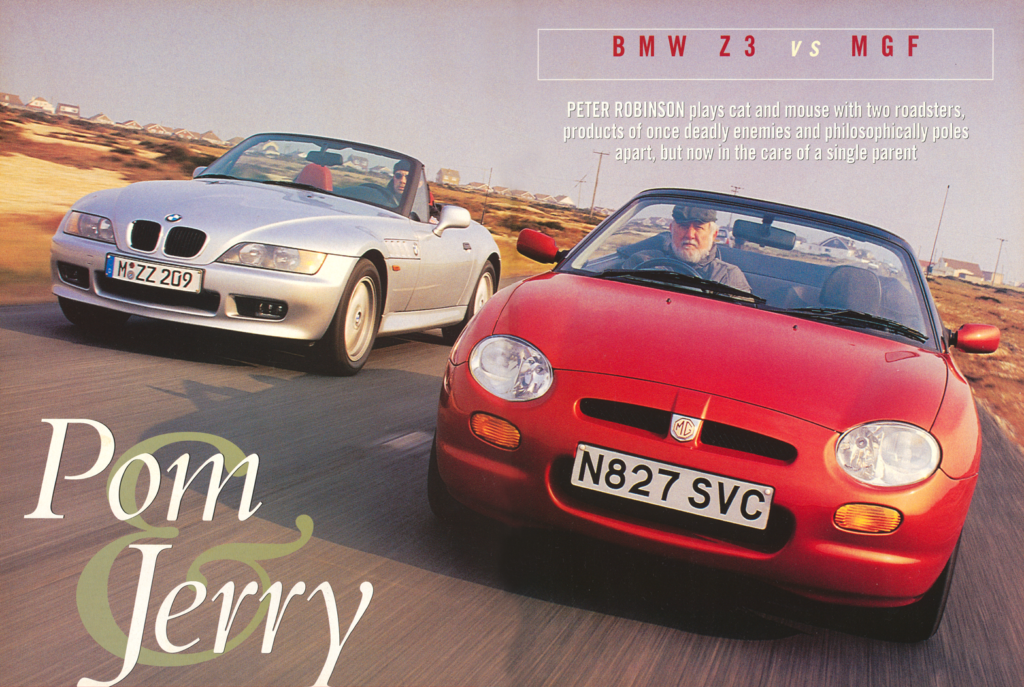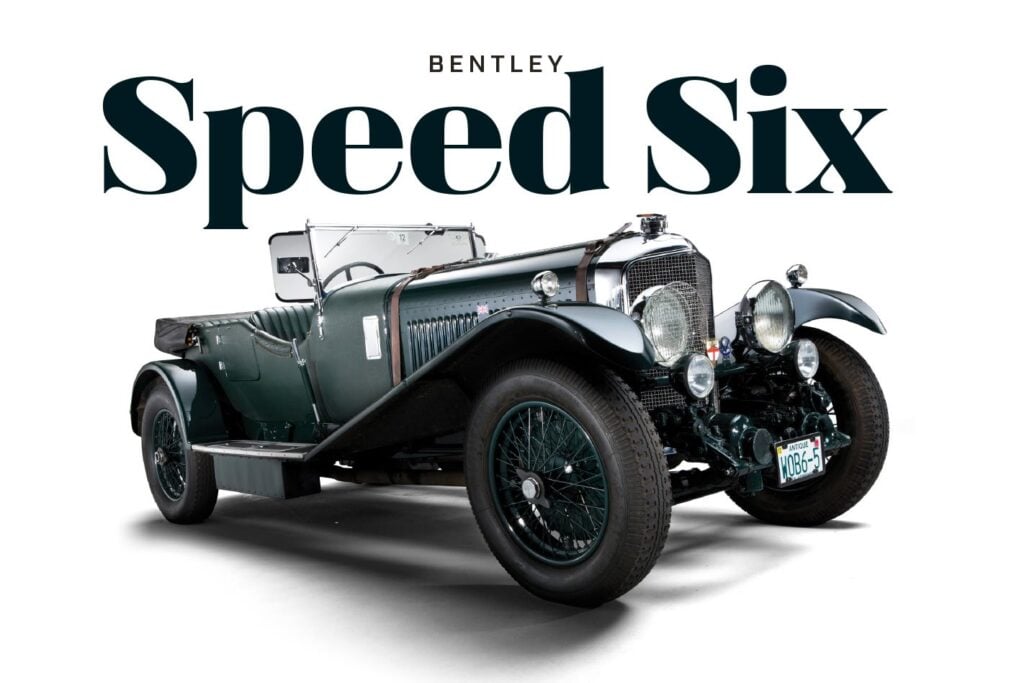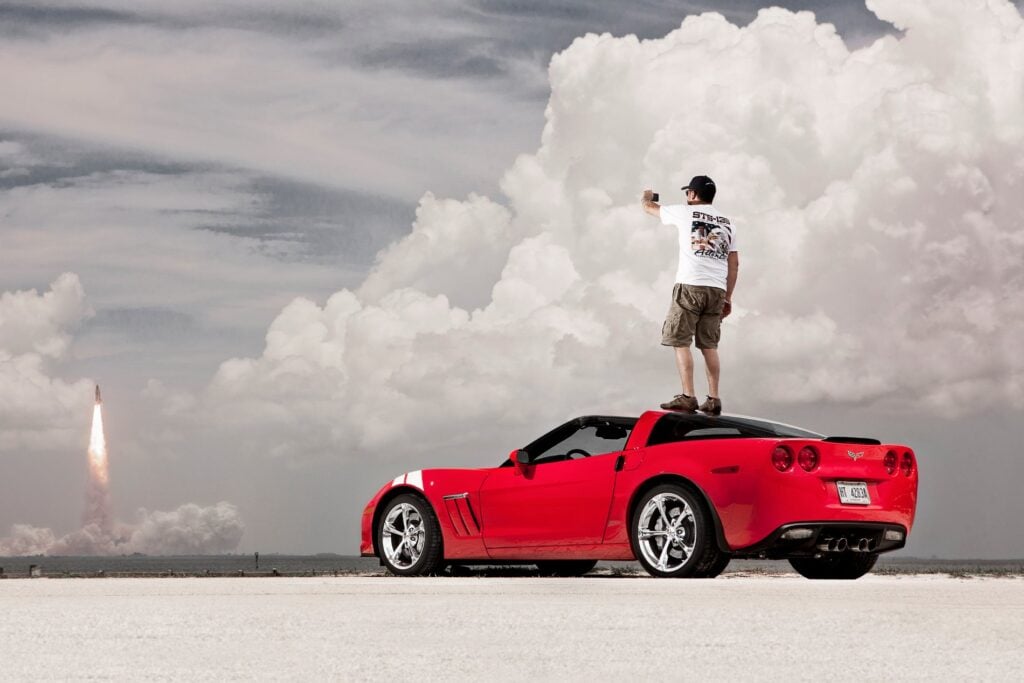AT KULGERA, 286km south of Alice Springs, 1814km from Darwin and almost 16 hours and 1500km since leaving Adelaide, we needed a drink. It was soon after eight in the morning, the sun was eyeball-piercing bright but not yet too hot, and the genuine, all-Australian Big Sky was all around us.
Only the rambling roadhouse, set on so many acres of flat dirt, got in the way. We had survived! The big ‘roos at dusk the previous evening, the 900km of corrugated dirt road, the thunderous road trains which you follow for a couple of km with zero visibility before overtaking in a rainstorm of rocks, the suspension-cracking flood ways, the cows, the … All were behind us. And we went into the Kulgera roadhouse, thought about the Sunday-afternoon-drive of a journey (bitumen!) that lay ahead, ordered our drinks and played Space Invaders.
There were two surprises to contemplate that bright morning. The first was that expedition planner and leader Matt Whelan, veteran of many an Australian motoring marathon, blasted the Mother Ships on the haunted fish tank as if there were no tomorrow (he practises on a machine at the office, the cad), and the second was the car. We had just completed the most demanding drive that I, certainly, have ever done, and we had completed it without one worry, complaint or misgiving. What was this car that had been averaging about 100km/h over the dirt, that had been as surefooted as we could have wished, that had been quiet, comfortable and roomy enough to allow each of us fairly undisturbed sleep? A Commodore, a Falcon, perhaps? Maybe an Alfa, or BMW or Jaguar?
The car that had taken us to Kulgera so swiftly and securely, and the car that would go on to reach Darwin, 3262km from Adelaide, in 30 hours for a stops-and-all average speed of 110km/h, was none of these. It was a medium-sized, medium-priced Japanese sedan intended for taking the kids to school as much as anything else. But as this hard, long drive showed – and as WHEELS‘ other reports on the car, including the comparison in this issue, have reinforced – the Datsun Bluebird is no ordinary Japanese car.
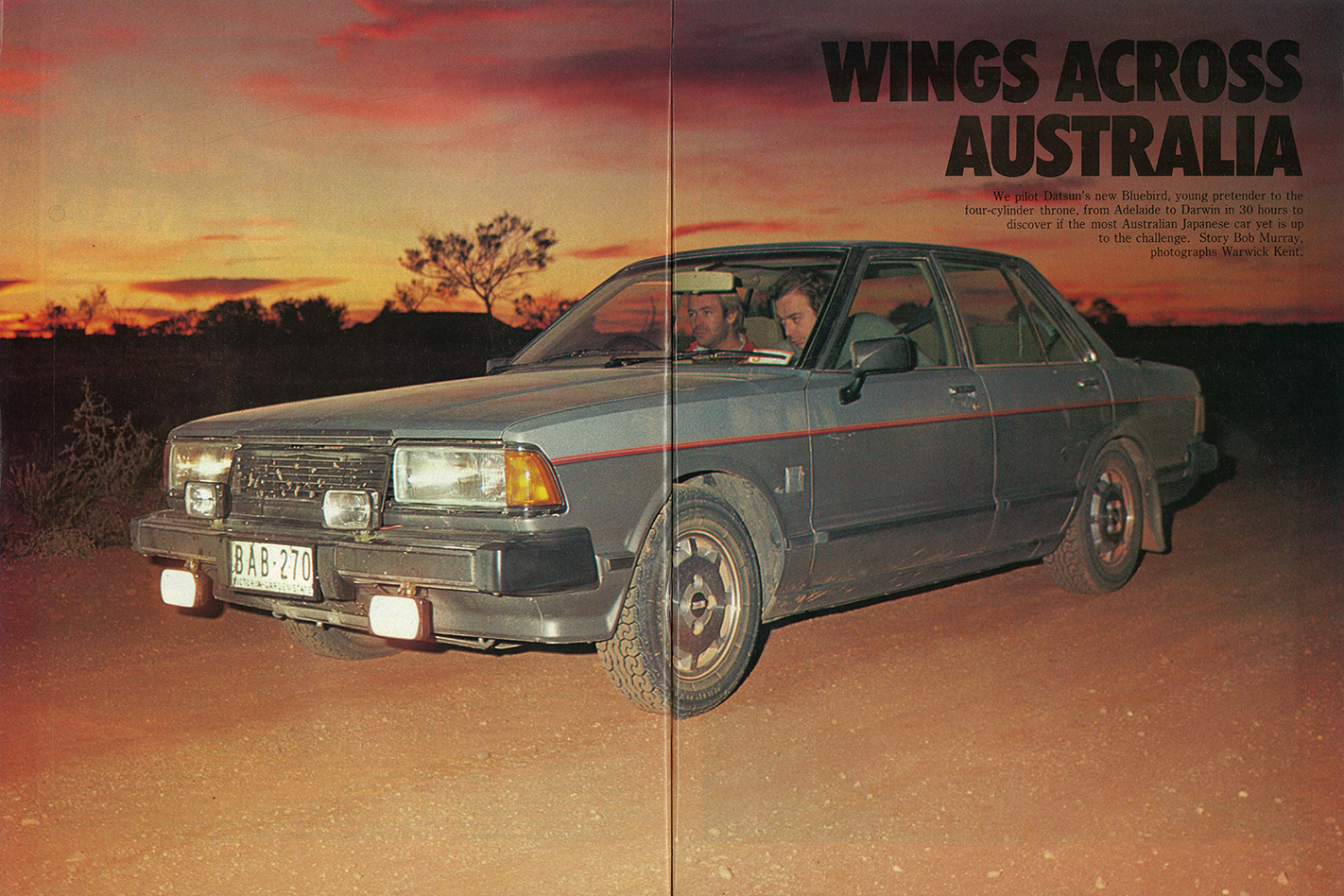
It’s 85 percent Australian for one thing. Only the body panels, five-speed gearbox for the top model and the rear axle are shipped to Nissan’s Clayton plant from Japan; the rest, including many locally designed parts like the legroom-boosting seats, are sourced in Australia. It’s the first time that Nissan here has gone for 85 percent local content with car number one. Usually – as in the 200B’s case – it starts at around 70 percent, working up to the magic figure with monthly increments. It’s not hard to imagine how such a policy could upset the Australianisation of a car. With the Bluebird there was no such risk, for the car was re-done in one hit, after many months and kilometres – some prototypes ran for 240,000km – of testing on the very roads in the middle of Australia that we were to attempt on the Adelaide to Darwin run.
We hadn’t done Adelaide to Darwin before, and the choice of the trip as a proving run for the most important new car to be introduced in Australia this year – Datsun is quite clear on the Bluebird’s intention: it is to become the country’s top-selling four-cylinder car – was straightforward enough, though there were variables to consider. Like the weather. With the amount of unsealed road on the way rain would have spelt an unacceptable extra hazard. We had to check petrol availability. We had to work out a schedule that would optimise 1 average speeds for each section (Whelan to the rescue). And we had to have a car. Datsun was 100 percent behind the trip from the start. Unstinting efforts on the part of PR man Don Alexander secured for us a Bluebird LX sedan with the five-speed and optional, and very comforting, power pack. Plus a boot load of the most common spares, two spare wheels and tyres and jerry cans for extra fuel and water. Plus the services of a fully-staffed and equipped workshop, ready to check the car and change wheels, at Alice Springs, the half-way point.
We had considered having long range fuel tanks plumbed in, but time was against us; so the $9750, electric-everything Bluebird that we set eyes on for the first time amid the churches of Adelaide was exactly the car you will buy -with the exception of radiator and sump guards, four driving lights and sticky tape over the badges of this “still secret” car. To the man walking his kids in the I Adelaide park: yes, this is your new 200B. We met at Sydney airport. Whelan, Warwick Kent – the bloke who took these ace pix – and me, on Friday, May 1, the day after my birthday, and the day after Matt was up all night finishing his new magazine, Your Computer. It was very definitely the morning after the night before. In Adelaide we checked into the poshest hotel we could find (thanks, Kerry) with the aim of getting our heads down while Warwick, who is never less than 100 percent, did the shopping. Dried fruit (30 hours later, only the prunes were left), devon, dry biscuits, pumpernickel, fruit cake, salami, flavoured milk and bottles of tonic water. Whelan had his own supply of tucker: on these occasions he subsists on a diet of Marlboro, Cocoa-Cola and Arnott’s arrowroot biscuits. In between trips to the well-stocked refrigerator in the hotel room, it took two hours to work out this shopping list.
We left Adelaide at 5.20pm local time, an hour and a half behind schedule and in the middle of the (thankfully light) Adelaide rush hour. Port Wakefield, Port Pirie and Port Augusta for fuel was the first leg, and we did this 311km stretch in not-quite-three hours for an average of 120km/h. We had watched the sun go down over Adelaide, and at Port Augusta as we pumped in 38.8 litres (to give 8km/l or 22.6mpg) it was quite dark. Exactly according to plan.

Now this plan was Very Clever. It involved leaving Adelaide at a time that would put us at the start of the dirt at nightfall, so that most of the rough stuff would be despatched under cover of darkness. There would be animals, sure, and there would be grumpy roadhouse owners who would be only too happy to relieve us of five bucks’ service charge for being woken at three in the morning in order to sell us some fuel. But with our extra lights we would be able to post average speeds not all that far adrift of the speeds we could expect if the currant bun were high in the sky: leaving the precious daylight hours for the good, bitumen roads later on when we would drive pedal to the metal and need every ounce of visibility. The occasional sleeping cow, insomniac wombat or somnambulistic ‘roo looks a lot better through the Ray Bans at 160km/h …
I saw my first kangaroo on the fast road from Port Augusta to Woomera. My first live ‘roo. We knew they were around for every few hundred yards there would be parallel strips of black rubber on the road, and a few feet after they had stopped, just as suddenly as they had started, there would be a patch of red.
Then there they were, standing at the side of the road watching us, waiting till we, too, had insufficient distance to stop securely before moving. We drove round the ‘roos a couple of times, and one, hypnotised by our lights’ beam, raced us up the road, but we didn’t hit one, nor even come scarily close to hitting one. I am eternally grateful.
At Woomera the bitumen ran out.
Several thousand suspension-pounding corrugations and about four corners later we were at Kingoonya, and it didn’t matter that beneath the Datsun’s wheels were dust and rubble. We still had a frightening distance to go on the dirt, but our spirits were up and even at this early stage the car’s superiority was clear to one and all; it wasn’t, after all, going to be a spine-jarring, bum-numbing, headache-inducing nightmare of a journey in just another poorly suspended Japanese car.
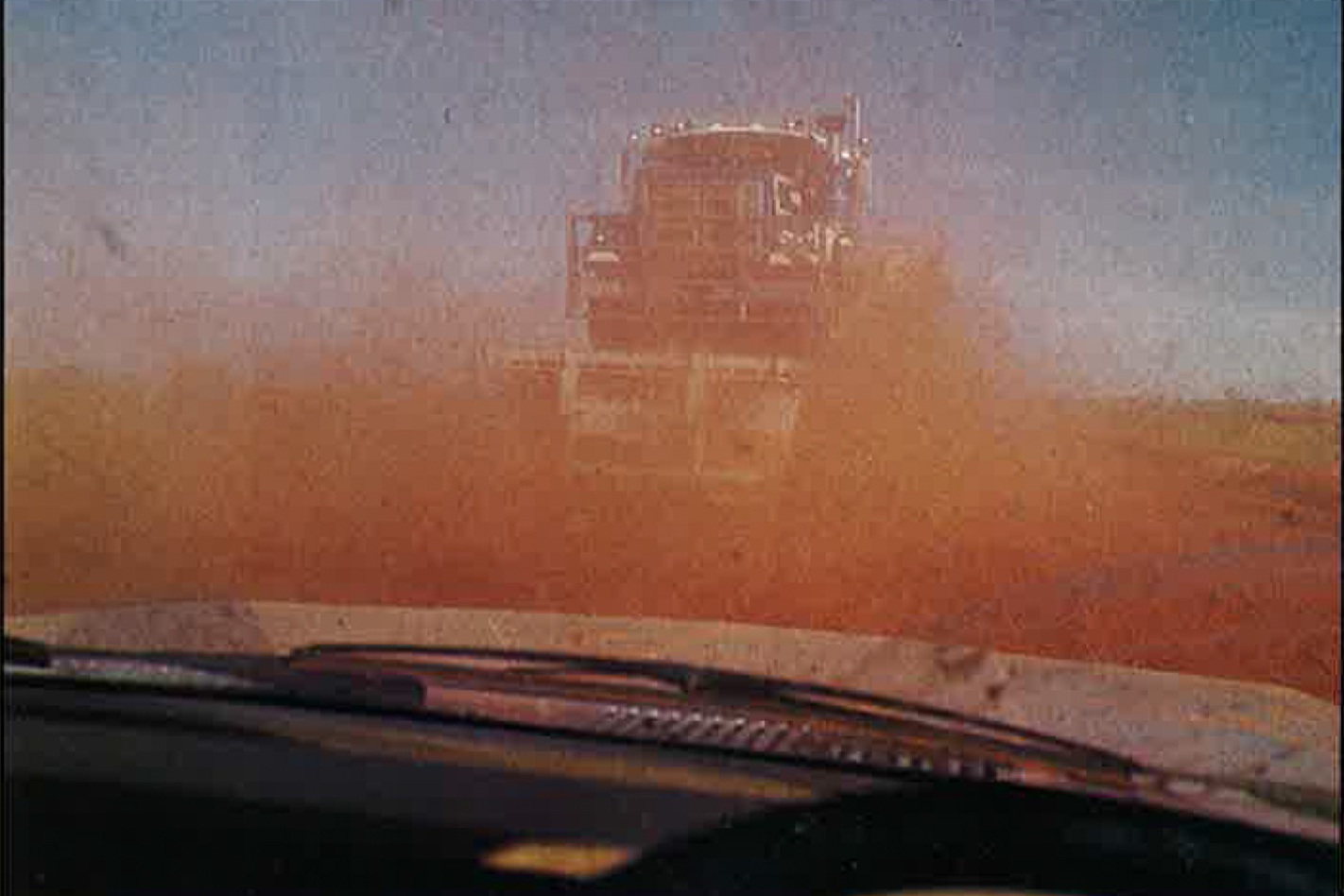
In between the road trains and the corners were the grids and the floodways.
I was instructed in a driving technique known as the Floodway Flick. Now there’s not much call for this in Sussex, but Matt and Warwick were patient and they explained all, emphasising that if the car was to reach Darwin without the front shockers sticking up through the bonnet we just had to meet any ridges in the road sideways. Gives the front suspension a better chance and makes it easier to do something drastic the other side if the road does something silly, like an abrupt U -turn, they explained. It was okay when the road surface was predictable but too often there were dead animals to drive around, or huge potholes, or bits of truck tyre, or dips full of soft sand, which all added to the … er, fun.
So there we were, travelling sideways for much of the time, often in the dust and stones wake of a roadtrain that would crush a car without the driver realising it, trying to avoid all sorts of tyre-popping debris and attempting to drink Coke and eat arrowroot biscuits, while the whole time keeping an eagle eye out for suicidal animals lurking in the bushes. London’s Hyde Park Corner in the rush hour comes close to this, but, gee whiz, that drive takes the biscuit.
At Kingoonya we turned right, one of only a handful of turn-offs. We arrived at 11.25pm and were away again with an extra 44.75L on board (average speed since Woomera, 98km/h; fuel consumption, 7.8km/L or 22.1mpg) 10 minutes later. We drove on over the dirt to BonBon, Mt Eba, Ingomar and Coober Pedy to post near-identical speed and consumption figures. There was less traffic now – a roadtrain, coach or car every hour instead of every 30 minutes – but the road was as surprising as ever, and we didn’t have enough visibility at the 120km/h-plus speeds that would be needed were we to up substantially our average. So we sat on 100 or so.
After filling up courtesy of one of the aforementioned sleepy-eyed roadhouse owners (it was now 2.30am) we zoomed past the handful of buildings that make up the visible Coober Pedy without hearing or seeing one clue to the thriving community below us. What a fascinating place this underground mining town must be, and I craned to see at least something to tell the oldies. But through the rear window there was only a swirling cloud of red dust, and ahead there was only a very lonely, mysterious darkness that shrouded the road that stretched for 450km into the distance to the border between South Australia and the Northern Territory and the start of the bitumen.
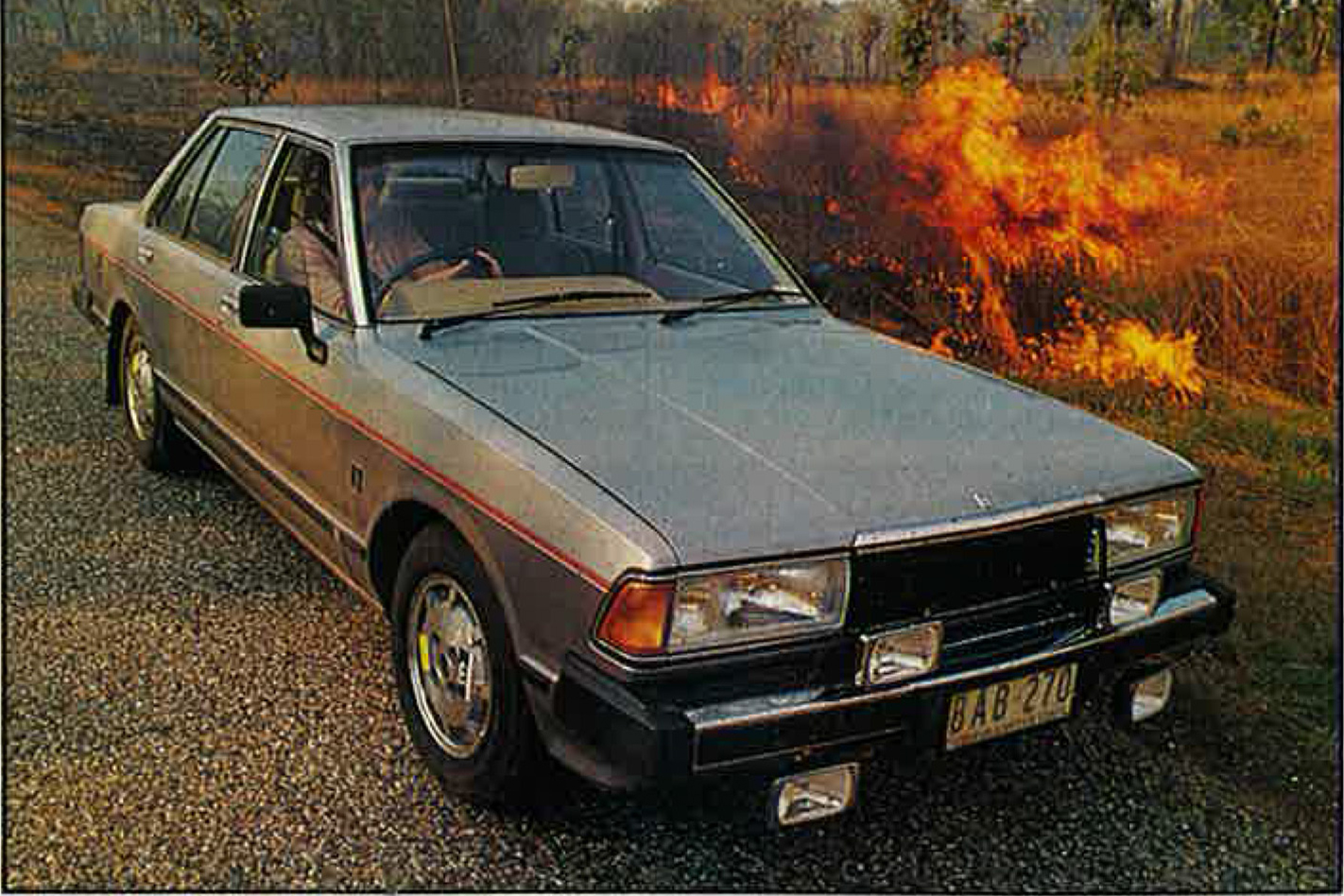
Before our next fuel stop at Marla Bore, 299km from Coober Pedy, we had our first flat. Matt was driving and he spotted it almost immediately – something that I, later on the return leg, was to realise as being a very difficult thing to do, as we manhandled a multi-holed, wheel chipped, red hot remnant off the rear axle. But Matt had picked this one early and it was changed easily. There was some dust in the boot but we expected that; short of being airtight, there had to be. There was dust in the car, too, we noticed that’s no reflection on the sealing or air conditioning, since we had inadvertently left a window open as a road train went by – a fine, red powder that lay in every crevice, coated every flat surface. It was in our hair, behind our fingernails, and on our salami and pumpernickel. But it didn’t matter. Not much, anyway.
We averaged 103km/h to Marla Bore and, with the help of a spectacular dawn, (look at those pix) another 103km/h to Kulgera. We stopped for a train and we stopped to let Warwick do his stuff, and, on the last section of dirt, we hit two floodway dips that I expected would crack the car clean in half. Floodway Flick to the rescue. I saw both of them far too late and the Bluebird, that poor Bluebird, went over them far too fast. I had braked hard to the last possible moment, I had twitched the car sideways and I had got hard back on the power to bring the nose up. But it was still a big crash, and I expected to see the shockers poking up through the bodywork at any moment. Once we had landed (gulp), and were fishtailing off up the road, we scanned the dirt behind us for the odd wheel or axle we might have left behind.
We saw the heat shimmering off the bitumen for about a km before the dirt ran out. We fixed our eyes on it: a solid, black line that spelled 160km/h and an end to the inescapable dust and corrugations. Then we were on it, and we rode in a Rolls-Royce all the way to Kulgera and the cold beer and the Space Invaders.
We were disappointed with the Kulgera to Alice Springs average speed for, at 159km/h, it was one kay less than it should have been. We made up for it on the stretch from Alice Springs to Tea Tree, however, when, full of hamburgers and new vigour, the accelerator pedal was clamped mercilessly to the floor for 200km and one and a quarter hours – exactly 160km/h and, surprisingly for a modern car, exactly 160km/h showing on the spot-on speedo. The needle of the big “econometer” at this stage was resolutely in the red, showing zero economy. That wasn’t quite true, for the car returned 6.6km/l (18.6mpg), the poorest consumption figure of the trip, though not unacceptably so.
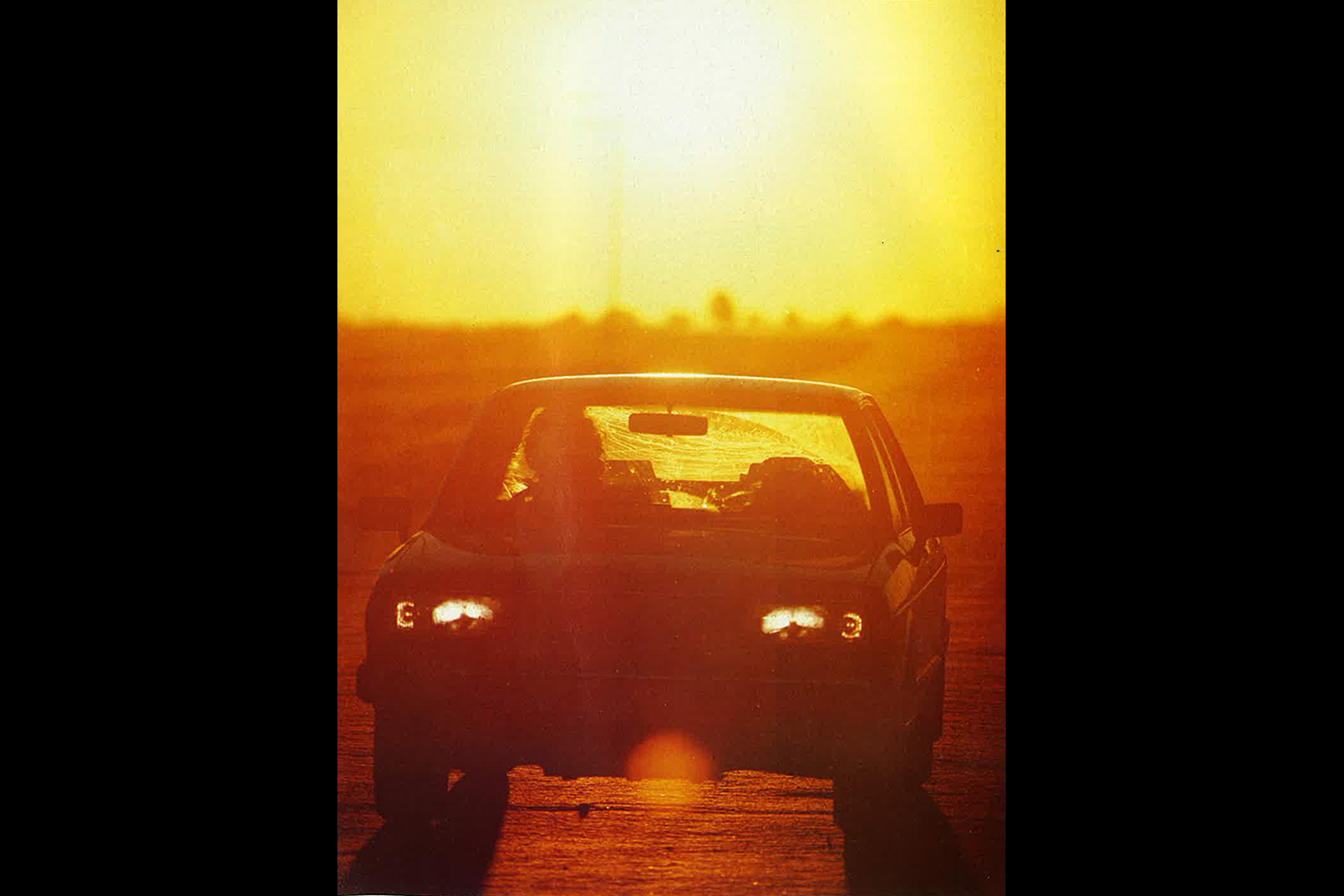
We arrived in Alice shortly before 11am and headed straight for the Datsun where a great bunch of blokes who had sacrificed their Saturday morning were waiting to check the car. Was there anything wrong with it, they asked? It hadn’t struck us before but, after looking at one another and scratching our heads, we realised: there was nothing wrong with the Bluebird. It had worked, and gone on working despite terrible odds, to our complete satisfaction. The car went up on a ramp and I expected to see the most awful damage to its underside, but there were only a couple of gouges in the sump guard as testimony to its thrashing. Apart from that, the paintwork-hiding dust and the two screws, one from a sun visor and one from the air conditioning that had fallen out, the car could have been driven to the garage from one block away.
With new wheels and tyres beneath us and all the fluid levels checked we aimed the Bluebird north on the narrow strip of road, with gravel run-off areas either side for passing, and watched the kilometres flash by. Over the Tropic of Capricorn to Aileron, Tea Tree, Barrow Creek, Wauchope and the spectacular Devil’ s Marbles rock formation soon after. To Tennant Creek, Three Ways (where we would turn left for Sydney on the return), Elliot, Dunmarra, Daly Waters, Larrimah, Katherine. There was the occasional sidetrack where the road was being worked on, and there were a few twisty bits, too, most of which the Bluebird would happily take flat out, but generally the road was fairly smooth, very straight and very fast. It was narrow, though, and in a car with poor stability and sloppy steering would have no fun at all. We had no such worries.
Suddenly we realised the pace we would have to set to reach Darwin by 11.20pm, the 30 hour mark. We hadn’t thought of the trip as being any sort of race or record breaking attempt, merely a long, fast drive with no unnecessary stops, the odd game of Space Invaders apart. But now it seemed that 30 hours was a reasonable target to aim for, and we went for it. At the garages one of us put in the petrol, one paid for it and filled in the log, and the other cleaned the windscreen and the lights (by now the mesh radiator guard looked like a lepidopterist’s prize exhibit).
At Katherine a very determined Matt took the wheel after a commanding stint by Warwick and we left the roadhouse four minutes after arriving and scorched past the “Danger – Water buffalo on road” signs for the last leg to Darwin, a beer, a shower and bed.
At 11.19pm, 29 hours and 59 minutes (it’s true, it’s true!) and 3262km, 2026 miles, since Adelaide, Matt drove one very dirty Bluebird into Darwin. We looked at the palm trees, gazed towards the Timor Sea and drove around town for 20 minutes looking for the centre, till we realised we were in it. The brass band that should have been there to welcome us had obviously got lost, we reasoned. It was too windy for a firework display and the Mayor, we supposed, was elsewhere engaged. It would have been nice, however, if somebody, anybody had said well done chaps! Welcome to Darwin.
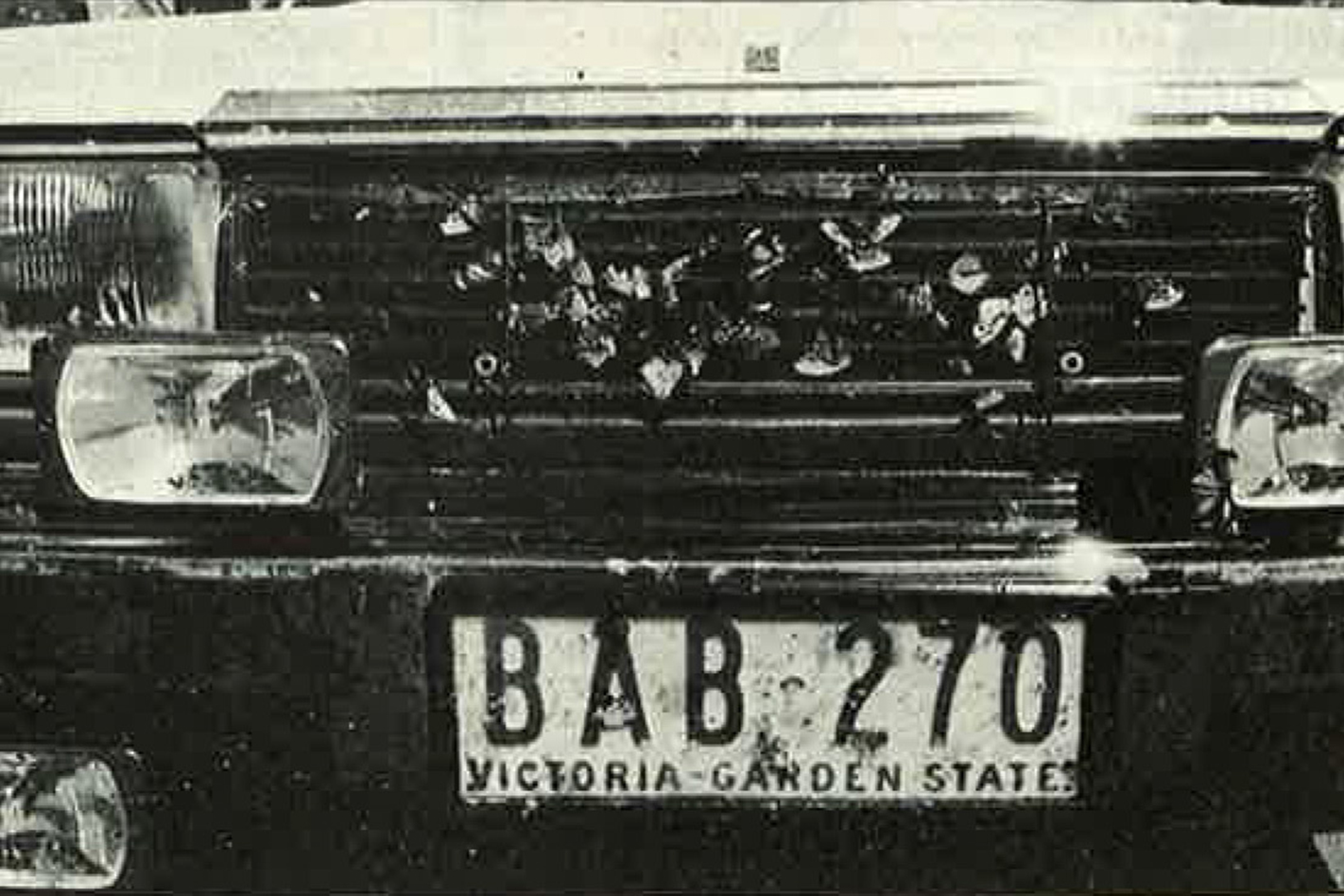
We took ourselves off to the motel at Fannie Bay. We saw the bay, but of the other there was no sign.
The next day we put Matt Whelan and the two Tequila Sunrises inside him on an aeroplane for Sydney, and Warwick and I set course for Katherine again, and our overnight stop. From there we went to Three Ways, turned left, and reached the mining town of Mount Isa in time for dinner. From here, incredibly the biggest city in the world with an area the size of Switzerland, with sunshine for 360 days a year and with Australia’s biggest thirst for beer, we took the only partly sealed Landsborough Highway to a charming town called Longreach.
We left Longreach at 8.30 in the morning and we reached Sydney, 1800km away, at 11pm. We hadn’t intended to do the journey in one go, but we reached Bourke in good time, went on to Nyngan, thought what the hell and cruised through Dubbo and Orange, and then at Bathurst we saw a Highway Patrol car and knew we were home.
If we had harboured any doubts about the car that last journey would have shattered them. Comfort, quietness, security – all the important things about a car that allow you to travel long distances safely and enjoyably were evident with every kilometre. Yes, the engine feels a little gutless in the mid ranges; yes, the drivetrain still lacks the refinement of a good European car; yes, the car moves around on bumpy straight roads, and, yes, headroom in the front is tight. But, really, these criticisms are to salve the motoring writer’s conscience; we do, after all, have to earn our living and criticise something.
It’s not anywhere near being perfect, but, by heaven, the Datsun Bluebird is a good car. You may think this story is more about a journey than a car, but you would be wrong, for it is all about the car. All about a car which all three of us enjoyed; a car which any one of us would be willing to take on that same journey again tomorrow. I think that’s probably the best thing I can say about the Bluebird.
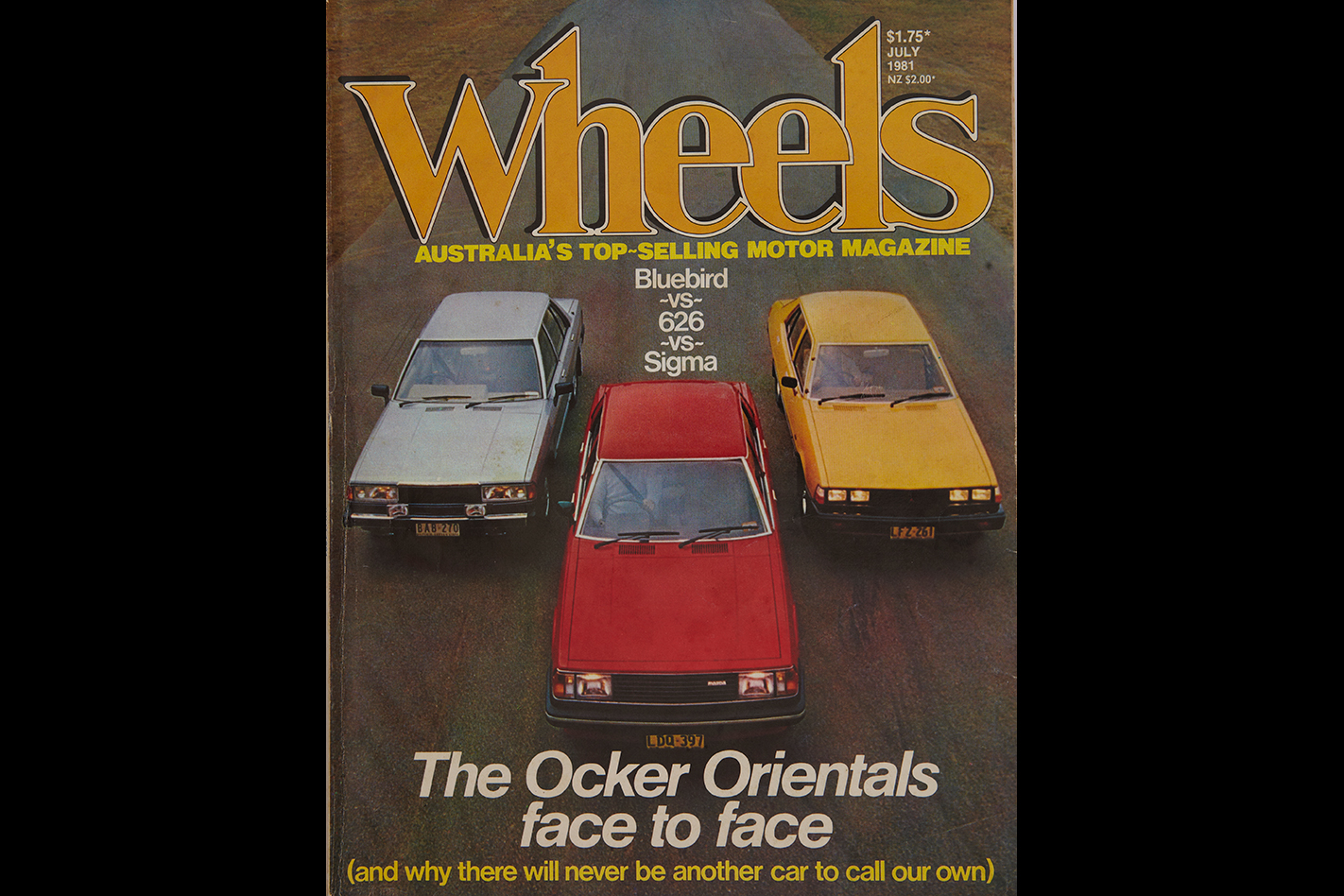
‘Wings Across Australia’ originally appeared in the July 1981 edition of Wheels.

